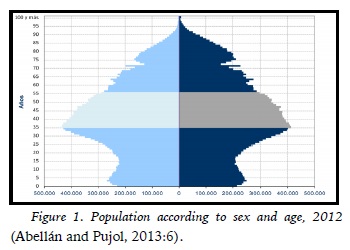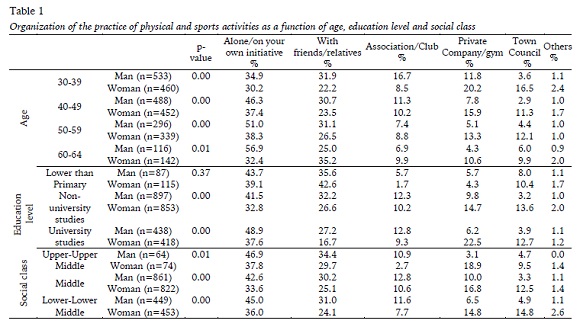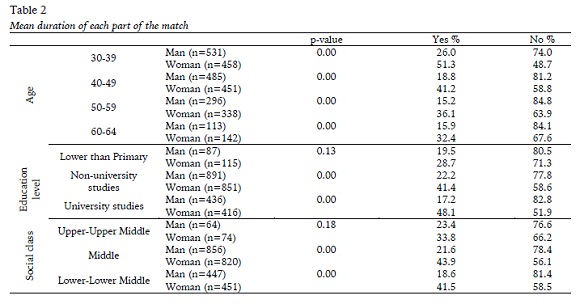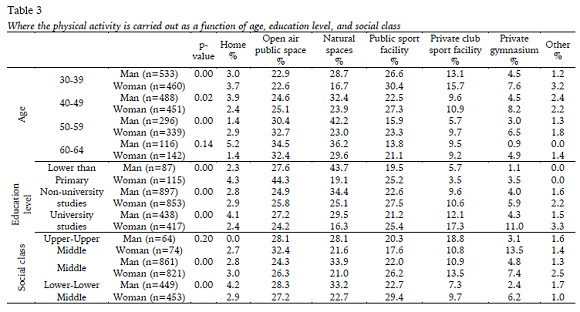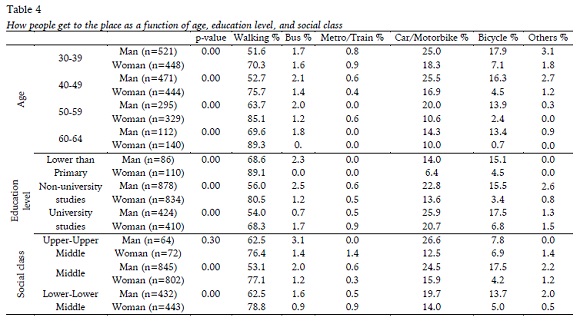Serviços Personalizados
Journal
Artigo
Indicadores
-
 Citado por SciELO
Citado por SciELO -
 Acessos
Acessos
Links relacionados
-
 Similares em
SciELO
Similares em
SciELO
Compartilhar
Motricidade
versão impressa ISSN 1646-107X
Motri. vol.15 no.1 Ribeira de Pena mar. 2019
https://doi.org/10.6063/motricidade.13997
ARTIGOS ORIGINAIS
Organizational aspects of adults’ sports habits in Spain: gender and social differences
María Espada1[*], María Martín1, Víctor Jiménez2, David del Hierro1, José-Antonio Santacruz3, José-Emilio Jímenez-Beatty3
1Facultad de Ciencias de la Actividad Física y del Deporte. Universidad Politécnica de Madrid.
2Facultad de Salud. Universidad Camilo José Cela.
3Facultadde Medicina y Ciencias de la Salud. Universidad de Alcalá
ABSTRACT
The objectives of the present study were to determine if there exist differences with regard to gender in the organizational aspects related to adults’ sports habits in Spain and to analyze these organizational aspects as a function of age, level of completed education and social class. The research followed a quantitative methodology using a questionnaire that was administered to a sample of 3,463 subjects, 1,732 men (mean age 46.6 years ± 9.7) and 1,731 women (mean age 44.5 years ± 9.6). The results show that there exist significant differences in organizational aspects of sports habits between men and women and present interesting information for organizations about these aspects as a function of the different socio- demographic variables.
Keywords: physical activity, organization, gender, level of completed education, social class.
INTRODUCTION
Adults are currently the most numerous group in the Spanish population: one out of every two people in Spain is between the ages of 30 and 64 years (Instituto Nacional de Estadística, 2014). The importance of this group incorporating regular physical activity into their lifestyle with the purpose of obtaining numerous benefits not just for their physical but also their psychological, affective and social health cannot, therefore, be overemphasized (Salvador et al., 1995; Laurin et al., 2001; Strawbridge et al., 2002). See Figure 1 Population according to sex and age (Abellán and Pujol, 2013: 6)
The different sociological studies which have been carried out on sports habits in Spain - by the Center for Sociological Research, financed by the High Council for Sport and directed by Manuel García Ferrando - have shown over the last few decades that the number of people practicing sport in Spain has been on the increase.
This circumstance may have important repercussions on health and quality of life, as well as present and future health costs, mainly in the case of women, as they have a greater life expectancy and prevalence of the disease. However, women participate less in physical exercise than men (Fasting et al., 2014).
Differences have been found in the type of activity practiced and its characteristics in several research projects related to the practice of physical activity in Spain with regard to gender (Buñuel, 1994; García Ferrando and Llopis, 2011; Martínez del Castillo et al., 2009; Puig and Soler, 2004). In their youth, adulthood and old age, women mostly practice activities aimed at keeping fit for health such as organized indoor fitness maintenance or collective fitness-wellness classes, while men mostly practice more intense competitive and autonomous activities in the open air. A review of studies carried out in Europe presents similar results and led Talleu (2011:9) to speak of “two separate sports worlds” as there are differences with regard to gender in activities practiced, motivations and organizational mode between European boys and girls, men and women: most of the women practiced recreational activities related to health provided by private commercial organizations, while the men practiced more intensive, competitive and risky sports autonomously or in the framework of traditional sport organizations like sport clubs and federations.
With regard to this question, Puig and Soler (2004), considered that, as Spanish women have begun to take up the sport, far from reproducing male behaviors, they have modeled it around other parameters, creating a new and specifically feminine sport culture.
According to these authors, the theoretical analysis proposed by Bourdieu, of considering that people who practice a sport configure a field of interactions and diversity generated by the different capitals which they possess - economic, cultural, social or symbolic - contributes to explaining that women have configured their own sports fields in a different way from men.
Moreover, Puig and Soler (2004) and Martínez del Castillo et al. (2009) suggest approaching the differences and inequalities in sport from the perspective of the Feminist Theories of Difference which, without ignoring situations of inequality and even oppression, try to analyze what women specifically contribute to sport. This perspective for analysis makes it possible to study women’s sports culture in the framework of a sport system that enjoys neither the social evaluation nor the protagonism devoted to men’s sports culture.
Due to the scarcity of studies about adult men and women who practice sport carried out after the start of the present economic crisis, and with the idea that knowing their demands is one of the requisites for public and private sport organizations to be able to adequately adapt their provision of services, the objectives of the present study with regard to the population of men and women between 30 and 64 in Spain were:
- To determine if there exist differences between the genders in adults’ sports habits related to organizational aspects in Spain.
- To analyze and describe adults’ sports habits, related to organizational aspects in Spain as a function of age, level of completed education, and social class.
METHOD
Participants
The sample had the following characteristics: the final size of the sample was 3.463 adults, 1.732 men (mean age 46.6 years ± 9.7) and 1,731 women (mean age 44.5 years ± 9.6).
Procedures
The methodology consisted of carrying out structured interviews with a statistically representative sample of men and women between the ages of 30 and 64 in Spain (47.265.321 adults, 23.966.965 women, and 23.298.356 men, according to the National Institute of Statistics, Municipal Census 2012). Given that the population is infinite or very numerous, working with a confidence interval of <95.5%, and assuming in the populational variance the most unfavorable case of p equals q, the sampling margin of error was ± 1.7%.
The sampling method chosen was multistage probability (Bryman, 2004). In Stage one, the sampling units were municipalities; that is, there was a random selection of municipalities in Spain, where the interviews with the adults were to be carried out using the questionnaire. Interviews were conducted in proportion to the number of adults residing in the municipalities in Spain, according to their population (less than 10,000 inhabitants; between 10,000 and 50,000; between 50,000 and 100,000; and more than 100,000).
In Stage two, the sampling units were the 348 streets at the start of each interviewer’s route (there were 348 routes) in each of the boroughs selected in the previous stage. These streets were randomly selected. Each interviewer’s route consisted of ten interviews; that is, the questionnaire was to be administered to ten adults, five women and five men (selection was made proportional to the gender distribution of the population of adults residing in Spain).
In Stage three, the sampling units were the adults (N=3.480) that should be selected for interviews in their homes, using the research questionnaire. Only one adult was interviewed in each home; the only selection criterion was that the person had to be between 30 and 64 years, and they could be either male or female, depending on the interviews pending in each route. Each participant was informed about the characteristics of the research, the anonymity of their answers, and their protection according to the Data Protection Law. When the participants gave their verbal consent to participate in the study, we proceeded to apply the questionnaire. Finally, a total of 3.463 adults gave their consent to participate in the research.
The study was approved by the Institutional Review Board of the Polytechnic University of Madrid, Faculty of Sciences for Physical Activity and Sport.
The fieldwork was carried out from October to December 2012, January and February 2013, and October to December 2013. The interviewers applied the written questionnaire in personal face-to-face interviews in the adult's normal home. Since the sample is random and probabilistic, the results could be generalized to all Spanish adults.
The instrument used to gather the necessary information for the objectives of the study was based on the “Questionnaire on physical activity and sport in women: habits, demands and barriers” (Martínez del Castillo et al., 2005) designed to measure the demand for physical activity and other related variables in adult women, and secondly the “Standardized Questionnaire on Physical Activity and Elderly People” (Graupera et al., 2003) designed to measure the demand for physical activity and other related variables in elderly people, that has already been applied and validated in other studies.
Statistical analysis
The Statistical analyses were performed using Statistical Package for Social Sciences (SPSS) v18® for Windows. The following analyses were performed: descriptive analysis (univariate analysis using distribution graphs of relative frequencies and bivariate analysis using tables of relative frequencies) and inferential analysis using Pearson’s chi-square test. The level of significance was set at 0.05.
RESULTS
Table 1 presents the data obtained on the organization of the physical and/or sports activity as a function of age, level of completed education, and social class. If we focus on age, we can see that as this increases, the adults tend to practice on their own, with the exception of the older women. With regard to organizational entities, women prefer to practice in companies or gymnasia and men in associations or clubs. A moderate and statistically significant relation has been obtained between the physical and/or sport organization and the age ranges of 30 to 39 [χ2 (6)= 80.365; p=0.00; Φ = .28], and 60 to 64 [χ2(8)= 19.703; p=0.01; Φ = .27] and statistically significant but low in the age range of 40 to 49 [χ2 (6)= 47.670; p=0.00; Φ = .22] and 50 to 59 [χ2(6)= 30.770; p=0.00; Φ = .22].
With regard to the level of completed education, all the men independently of this variable carried out physical and/or sports activities mainly alone and on their own initiative. Similarly, the women with a non- university or a university education mainly practiced alone and on their own initiative, while women with a lower level of completed education mostly practiced with relatives or friends. However, no statistically significant relation was obtained between the organization of the physical and/or sports activity and the people with a lower level of completed education [χ2 (6)= 6.485; p=0.37; Φ = .17]. On the other hand, there was a low but statistically significant relation between the organization of physical and/or sport activity and people with a non-university education [χ2 (9)= 85.328; p= 0.00; Φ = .22] and a moderate one with the people with a university education [χ2 (6)= 80.805; p=0.00; Φ = .30].
All the subjects independently of their social class stated that they practiced physical and/or sports activity mainly alone and without supervision. Moreover, a moderate and statistically significant relation can be seen between who organizes the physical and/or sport activity and the subjects from the upper and upper middle classes [χ2 (5)= 13.795; p=0.01; Φ= .31] and a statistically significant but low relation with people from the middle classes [χ2 (6)= 76.191; p =0.00; Φ = .21], and lower and lower middle classes [χ2 (8)= 53.039; p=0.00; Φ= .24].
It should be emphasized that both men and women with a lower level of completed education and lower social class, present greater percentages of practice in activities organized by the municipality that are generally free or very low cost.
Table 2 shows the data obtained when analyzing if the practice of physical and/or sports activity is supervised by a monitor or teacher as a function of age, level of completed education, and social class. With regard to age, both men and women of all ages mostly state that they carry out physical and/or sport activity without the supervision of a monitor or teacher, with the exception of women between the ages of 30 and 39 where the percentage of those who say that they practice with supervision is slightly higher. It should be pointed out that a greater percentage of men than women at all ages practice autonomously and that there is a tendency for autonomous practice to increase as age increases in both groups. A moderate and statistically significant relation was obtained between supervision of the physical and/or sport activity and subjects of 30 to 39 years [χ2 (1)= 67.118; p=0.00; Φ =-.26] and a statistically significant but low relation with subjects of 40 to 49 [χ2 (1)= 56.673; p=0.00; Φ = -.24] of 50 to 59 [χ2 (1)=35.500; p=0.00; Φ = -.23] and of 60 to 64 [χ2(1)= 9.075; p=0.00; Φ = -.18].
With regard to the level of completed education, the majority both of women and men stated that they practice physical and/or sports activity without the supervision of a monitor or teacher. In this aspect, men with a university education are the subjects who present the greatest percentage of unsupervised practice. In contrast, the higher the level of completed education in the women, the lower the level of unsupervised practice. There is also a moderate and statistically significant relation between supervision of physical and/or sport activity and subjects who have a university education [χ2 (1)= 92.838; p=0.00; Φ =-.33] and a statistically significant but low relation with subjects who have a non-university education [χ2 (1)= 73.814; p=0.00; Φ = -.20]. There is no statistically significant relation between supervision of physical and/or sports activity and subjects who have a lower level of education [χ2 (1)= 2,229; p=0.13; Φ = -.10].
Similarly, the interviewees independently of their social class stated that during their practice of physical and/or sports activity, there was no supervision on the part of a monitor or teacher. The women from the upper class presented a larger proportion of unsupervised practice. Men, for their part, increased this mode of practice as their social class level decreased. A statistically significant but low relation was observed between the supervision of the physical and/or sport activity and people from the middle class [χ2 (1)= 94.827; p=0.00; Φ = -.23] and lower and lower middle classes [χ2 (1)= 55.966; p =0.00; Φ= -.25]. However, there was no statistically significant relation between the supervision of the physical and/or sports activity and people from the upper and upper middle classes [χ2 (1)= 1.785; p=0.18; Φ =-.11].
Table 3 shows the results obtained from the analysis of the place where the adults carry out their physical and/or sports activity. The majority of the men, independently of their age, stated that they practice physical and/or sport activity in natural spaces (countryside, sea, lake, reservoir, river, mountains, etc.) although an equal proportion of the men from the upper and upper middle classes practice in natural spaces and public sport facilities. With regard to the women, the results show that the younger women (from 30 to 49 years) mostly go to a public sports facility to practice physical and/or sports activities while women from 50 to 64 usually practice in a public space. A statistically significant but low relation has been obtained between the place where the physical and/or sport activity is practiced and the age range of 30 to 39 years [χ2 (11)= 32.383; p =0.00; Φ = .18] 40 to 49 years [χ2 (10)= 20.229; p=0.02; Φ =.14] and 50 to 59 years [χ2 (12)= 41.625; p=0.00; Φ = .25], while no statistically significant relation exists with people from 60 to 64 years [χ2 (7)= 10.836; p=0.14; Φ = .20].
Furthermore, women with a university education are the only ones who mostly carry out physical and/or sports activity in a public sports facility whereas the rest of the women prefer to practice in a public space in the open air. There is also a moderate and statistically significant relation between the place where the physical and/or sport activity is carried out and the people with a lower level of completed education [χ2 (5)= 16.755; p=0.00; Φ =-.28] and a statistically significant but low relation with those who have a non-university education [χ2 (14)= 32.899; p=0.00; Φ = .13] and those who have a university education [χ2 (12)= 47.385; p=0.00; Φ= .23].
Similarly, most of the women from the upper and upper middle classes stated that they practice in a public space in the open air while the women from the lower and lower middle classes mostly go to a public sports facility to practice physical and/or sports activities. The women from the middle class reveal practically the same proportion than those who practice physical and/or sports activities in a public place in the open air or a public sports facility. A statistically significant but low relation has been found between the place where the physical and/or sport activity is practiced and people from the middle class [χ2 (12)= 46.899; p=0.00; Φ = .16] and lower and lower middle classes [χ2 (10)= 28.084; p=0.00; Φ = .17], while there is no statistically significant relation with the people from the upper and upper middle classes [χ2 (8)= 8.428; p=0.20; Φ = .24].
Table 4 shows how the interviewees travel to the place where they practice physical and/or sports activities. Most of the men and women prefer, independently of their age, their level of completed education and their social class, to travel to the place of practice walking. However, it can be seen that a greater percentage of man from all the groups than women use their car. It is also evident that as age increases so the percentage of people who walk. A moderate and statistically significant relation has been found with the mode of transport in all age ranges, from 40 to 49 [χ2 (11)= 44.054; p=0.00; Φ = .28] from 50 to 59 [χ2 (6)= 48.690; p=0.00; Φ = .27], from 60 to 64 [χ2 (1)= 9.075; p=0.00; Φ = .30] except from 30 to 39 years where the relation is statistically significant but low [χ2 (10)= 48.619; p=0.00; Φ = .22].
Furthermore, it can be seen that a greater percentage of women with a lower level of completed education and a lower social class walk. A moderate and statistically significant relation has been found with the people with a lower level of completed education [χ2 (4)= 14.410; p=0.00; Φ = .27] and with those who have a non-university education [χ2 (11)= 139.221; p=0.00; Φ = .28] and a statistically significant but low relation with those who have a university education [χ2 (9)= 35.362; p=0.00; Φ = .20].
Finally a moderate and statistically significant relation has been found between mode of transport and the people from the middle class [χ2 (11)= 130.483; p=0.00; Φ = .28] and a statistically significant but low relation with the people from the lower and lower middle classes [χ2 (10)= 39.648; p=0.00; Φ = .21], while there is no statistically significant relation with the people from the upper and upper middle classes [χ2 (6)= 7,216; p=0.30; Φ = .23].
DISCUSSION
In the present study, it has been found that the majority of people practice physical and/or sports activities mainly alone and on their own initiative, independently of their age and gender. These data coincide with those of the latest survey of sports habits carried out in Spain by García Ferrando and Llopis (2011), which revealed that autonomous practice has increased (75%) and organized practice has decreased in both sexes and different age groups.
In the present study, results show that only women with a lower level of completed education mostly practice physical activities with relatives or friends, with the autonomous practice being the most popular, whether alone or with relatives or friends. This coincides with different studies which show that the people with a higher level of completed education are more likely to engage in organized physical activities than those with a lower level (Odunaiya, et al., 2011).
Similarly, interviewees independently of their social class, state that they mostly practice physical and/or sports activities alone and on their own initiative. In the study by Martín et al. (2014), with a sample of people from 30 to 64 years in the Madrid autonomous region no differences were found between genders with regard to the way they organized their activities as most of them practiced in an autonomous fashion (80.3% men, 63.7% women), and mainly alone (62.7% men, 50.5% women). This tendency constituted an important change in the Spanish market for sports services and began in the 1990s, although it has been more prevalent during the period from 2005 to 2010. Although, in other countries like Belgium, the participation frequency and time spent on sports increase when participants engage with the club- organized sport (Borgers et al., 2016).
In the same way, men and women of all ages mostly state that they carry out their physical and/or sports activity without the supervision of a monitor or teacher, with the exception of women between 30 and 39 years where the percentage of those who practice with supervision is slightly higher. This difference could be due to the services offered by private commercial organizations with flexible timetables and different activities in the fitness- wellness field which respond more adequately to the women's interests and lifestyles (Puig and Soler, 2004). Furthermore, studies like the one carried out by the National Women's Health Information Centre (2005) conclude that many women need someone to encourage them to exercise.
In the present study, there were no differences as a function of the level of completed education or social class as the majority of men and women state that they carry out their physical and/or sports activity without the supervision of a monitor or teacher.
The majority of the men, independently of age, level of completed education and social class state that they practice physical and/or sport activities in natural spaces (countryside, sea, lake, reservoir, river, mountains, etc.) although the same proportion of men from the upper and upper middle classes practice in natural spaces and public sport facilities. With regard to the women, the majority of them go to a public sports facility to practice physical and/or sports activities or to a public space in the open air. In a study by the Institute for Women in 2006, the men practiced in the open air to a greater extent than women (49.4% men, 38.1% women).
However, men are more likely than women to use public facilities (52.5% men, 49.4% women) while there are more women clients than men in private organizations like gymnasia or fitness- wellness centers (14.2% women, 11.7% men).
Concerning how the interviewees go to the place where they carry out their physical and/or sports activities, the majority of men and women independently of their age, level of completed education and social class, walk. In the study by Martín et al. (2014), there is a gender difference as fewer men (42.9%) than women (67.8%) walk to where they practice, as is shown in the present study in all population groups.
Regarding the limitations of the study, the fieldwork was carried out during the months of October to December 2012, January and February 2013 and October to December 2013 so the potential cross-sectional design may limit assessment of the temporal and thus potential causal relation of the variables. Therefore, it would be interesting to continue working in this field in Spain in the future to be able to verify that the variables studied are stable over time.
In this line of research, it would be interesting to draw up action plans which take the data recorded into consideration to improve the provision of physical-sport activities, as well as to carry out similar studies in other countries to discover the similarities and differences in organizational aspects of sports habits.
CONCLUSION
The present study shows the social differences which exist in the organizational aspects of the practice of physical activities in adults in Spain as a function of gender. It also describes the organizational aspects of adults’ sports habits in Spain as a function of age, level of completed education, and social class. For example, the results show that the majority of the women between 30 and 39 carry out their physical and/or sports activity with the supervision of a monitor or teacher. This result is important to the services offered by private commercial organizations; it could offer different activities with the supervision of a monitor or teacher in the fitness-wellness.
These results can be used by the different entities that organize physical and sports activities to adapt their programs to adults’ physical activity and leisure habits, bearing in mind the existing differences with regard to gender in some of the variables analyzed.
They also make it possible for them to compare the organizational aspects of adults’ practice of physical activities in Spain with those of other countries.
REFERENCES
Abellán, A., & Pujol, R. (2013). Un perfil de las personas mayores en España, 2013. Indicadores estadísticos básicos. Madrid: Informes Envejecimiento en red nº 1. [ Links ]
Borgers, J., Breedveld, K., Tiessen-Raaphorst, A., Thibaut, E., Vandermeerschen, H., Vos, S., & Scheerder, J. (2016). A study on the frequency of participation and time spent on sport in different organisational settings. European Sport Management Quarterly, 16(5), 635-654. https://doi.org/10.1080/16184742.2016.1196717 [ Links ]
Bryman, A. (2004). Social research methods. New York: Oxford University Press. [ Links ]
Buñuel, A. (1994). The social construction of women's bodies in sport. Revista Española de Investigaciones Sociológicas, 68, 97-117. [ Links ]
Fasting, K., Sand, T. S., Pike, E., & Matthews, J. (2014) From Brighton to Helsinki. Women and Sport Progress Report 1994-2014. Valo: International Working Group Women and Sport-Finish Sport Confederation. [ Links ]
García-Ferrando, M., & Llopis, R. (2011). The democratic ideal and personal well being, Survey of sports habits in Spain 2010. Madrid: CIS-CSD. [ Links ]
Graupera, J. L., Martínez del Castillo, J., & Martín, B. (2003). Motivational factors, attitudes and habits of practice of physical activity in older women. Serie ICD Investigation in Sports Sciences, 35,181- 222. [ Links ]
Instituto Nacional de Estadística (2014). INEbase. Demografía y población 2014. Instituto Nacional de Estadística. Consulta 01/10/2014 (http://www.ine.es ) [ Links ]
Laurin, D., Verreault, R., Lindsay, J., MacPherson, K., & Rockwood, K. (2001). Physical activity and risk of cognitive impairment and dementia in elderly persons. Archives of Neurology, 58, 498-504. [ Links ]
Martín, M., Barriopedro, M. I., Martínez del Castillo, J., Jiménez-Beatty, J. E., & Rivero, A. (2014). Gender differences in the habits of physical activity of the adult population in the Community of Madrid. RICYDE, 10(38), 319-335. DOI: http://dx.doi.org/10.5232/ricyde2014.03803 [ Links ]
Martínez del Castillo, J., González, M. D., Jiménez- Beatty, J. E., Graupera, J. L., Martín, M., Campos, A., & del Hierro, D. (2009). The habits of physical activity of the older women in Spain. RICYDE, 14, 81-93. [ Links ]
Martínez del Castillo, J., Vázquez, B., Graupera, J. L., Jiménez-Beatty, J. E., Alfaro, E., Hernández, M., & Ríos, D. A. (2005). Gender differences in the habits of physical activity of the adult population in the Community of Madrid. Madrid: General Directorate for equal opportunities. [ Links ]
National Women's Health Information Centre (2005). Facts and Figures: Girls' Health Statistics Across the Nation. Washington, DC: US Department of Health and Human Services.
Odunaiya, N. A., Aderibigbe, A. A., & Oguntibeju, O.O. (2011). Physical exercise: Knowledge, attitudes and habits of literate women in Western Nigeria. African Journal for Physical Activity and Health Sciences, 17(4), 790-804. [ Links ]
Puig, N., & Soler, S. (2014). Women and sport in Spain: The state of affairs and proposed interpretation. Apunts Physical Education and Sports, 76, 71-78 [ Links ]
Salvador, A., Suay, F., Martínez-Sanchís, S., González- Bono, E., Rodríguez, M., & Gilabert, A. (1995). Sport and health: effects of sports activity on psychological well being and underlying hormonal mechanisms. Revista de Psicología General y Aplicada, 48(1), 125-137. [ Links ]
Strawbridge, W. J., Deleger, S., Roberts, R. E. & Kaplan, G. A. (2002). Physical Activity Reduces the Risk of Subsequent Depression for Older Adults. American Journal of Epidemiology, 156(4), 328-334. [ Links ]
Talleu, C. (2011). Gender Equality in Sports: Handbook on good practices. Access for Girls and Women to Sport Practices. Bruselas: European Commission. [ Links ]
Acknowledgments: Nothing to declare.
Conflict of interests: Nothing to declare.
Funding: The research presented here is part of the R&D project DEP2010-19801 co-funded by the Ministry of Education and Science and the European Union (European Regional Development Fund). It also received assistance for R&D from the Universidad Politécnica de Madrid.
Manuscript received at February 22th 2018; Accepted at March 15th 2019
[*]Corresponding author: Calle Martín Fierro, 7, 28040 Madrid-Spain
Email: maria.espada@upm.es













